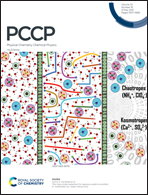A new perspective for evaluating the photoelectric performance of organic–inorganic hybrid perovskites based on the DFT calculations of excited states†
Abstract
The high efficiency of organic–inorganic hybrid perovskites has attracted the attention of many scholars all over the world, the chemical formula of which is ABX3, where A is an organic cation, B is a metal cation, and X is a halogen ion. In addition, the micro-mechanism behind the efficient photoelectric conversion needs more in-depth exploration. Therefore, in this work, based on time-dependent density functional theory (TD-DFT), the electron transfer mechanism from the ground state to the first singlet excited state was systematically investigated by electron and hole analysis and an inter-fragment charge transfer amount method (IFCT). In this work, we optimized and analyzed 99 different perovskite cluster configurations, where A sites are CH3NH3+ (MA+), NH2CHNH2+ (FA+), CH3CH2NH3+ (EA+), NH2CHOH+ (JA+), NH3OH+ (BA+), N(CH3)4+ (DA+), CH3CH2CH2NH3+ (KB+), CH3CH2CH2CH2NH3+ (KC+), C3N2H5+ (RA+), CH(CH3)2+ (TA+), and CH3NH(CH3)2+ (UA+), B sites are Ge2+, Sn2+ and Pb2+, and X sites are Cl−, Br− and I−. According to the analysis of a series of perovskite clusters of the hole–electron distribution, the distribution is mainly concentrated on BX, and electrons and holes are respectively distributed on B and X sites. The exciton binding energy decreases when the metal element changes from Ge to Pb and the halogen element changes from Cl to I. A radar chart including the exciton binding energy, excited energy, amount of net charge transfer, electron and hole overlap index, distance between the centroid of holes and electrons, and the hole and electron separation index was proposed to intuitively describe the electron transmission characteristics of perovskites. Based on that, a comprehensive score index was innovatively proposed to evaluate the photoelectric property of perovskites, providing foundational guidance for the design of high-efficiency organic–inorganic hybrid perovskites.



 Please wait while we load your content...
Please wait while we load your content...